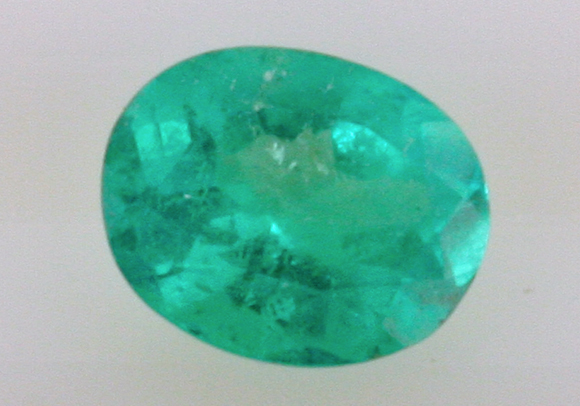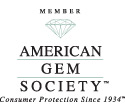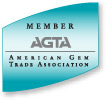Consumer Alert– Cruise Ships, Low Quality Emeralds, Very High Prices- Update
May 8th, 2014 by James L. Sweaney, CGA, FGA. GGUPDATE June 6, 2014 – A happy ending to the story below– 7 months after returning the emerald to the seller, the couple received their money back.
A retired couple purchased this 1.89 carat natural emerald last December in Cartagena, Columbia while on a cruise thru the Caribbean. The emerald shop they bought from had been touted by the cruise ship personnel as the biggest and best. Out of a room full of similar emeralds, the couple chose this one as one of the best. Upon returning from the cruise, they came to our shop and asked me to appraise it. As soon as I saw the stone, I sensed this would be a difficult appraisal, because the emerald was at the low end of the quality scale. I knew I would be the bearer of bad news.
The stone was poorly cut and heavily included so it had no brilliance or life. As you can see, the color was quite light for an emerald. The characteristics of the stone indicated it’s origin to be the Chivor mine of Columbia. We examined it carefully and concluded it was commercial grade emerald– ~ 2-3 on a scale of 1-10, 10 being best. After consulting with two gem dealers we deal with who know the material, we valued the stone at ~ $1200 – 1400 retail replacement value maximum. That means a consumer could buy a similar stone in the Southern California retail market for that price. Our client was shocked and upset. She had purchased the stone as a once-in-a-lifetime memento, the fulfillment of her dreams. The stone had been priced at $9000 US dollars! Her husband had bargained with the shop and had paid $5000, feeling they had a great value.
After finding out what the quality and value of the stone really was, they asked for a written appraisal so they could return the stone to the shop in Cartagena. A week later our client was back. The emerald shop was requiring a written appraisal done by an independent appraiser not affiliated with a jeweler before they would accept the return. We referred them to our friend and mentor, Coz Altobelli, one of the best known jewelry appraisers in the United States. Coz is the author of The Practical Guide to Jewelry Appraising, a highly respected reference work on appraising jewelry.
Following up for this blog, I spoke with our client today– she told me they had been working with the cruise ship company, didn’t have to have the independent appraisal after all, and the shop owner had agreed to refund the money. Her credit card company had held back payment as long as they could, but finally had to pay the vendor in Cartagena. Per the shop owner’s instructions, they had shipped the stone to a New York address– at a cost of $80. Bottom line- after almost 6 months and $185 of expense, our client admitted she still doesn’t have her money back– the shop in Columbia is claiming problems with their bank! Our client is optimistic that she will eventually get paid– let’s wish her luck.
Consumers should be aware that cruise ship companies may have relationships with or are investors in or are outright owners of shops in their ports-of-call. This can mean the cruise ship personnel have a vested interest in the shopping information they provide to cruising vacationers. Consumers should also be wary of purchasing gems in a foreign country for several reasons.
First, even though the country may be noted for producing a particular gemstone, i.e. Columbian Emerald, the best material produced is always routed thru the markets that will pay top dollar for top quality. Most tourists have spent a good chunk of money for the cruise and don’t have the cash or inclination to go big for a fine stone. Often, the tourist markets are a dumping ground for low end material that is hard to sell otherwise.
Second, the shops in cruise ship ports and other tourist destinations generally assume you will only shop with them one time so they have no interest in establishing a long term relationship. They will not educate you about the quality of gems– they only want to sell what they have.
Finally, in a foreign country, you are a long way from home in more ways than one. If you are confident and knowledgeable about your purchase, go ahead but don’t assume you’ll have the same buying experience you would have in your home town. The banking systems use different rules, the currency is different, and the culture is different than what we have in the USA. As you can see in this example, it can be difficult and expensive to return an item purchased in another country.
Tags: Caribbean cruise, Cartagena, Chivor emerald, commercial emerald., Coz Altobelli








